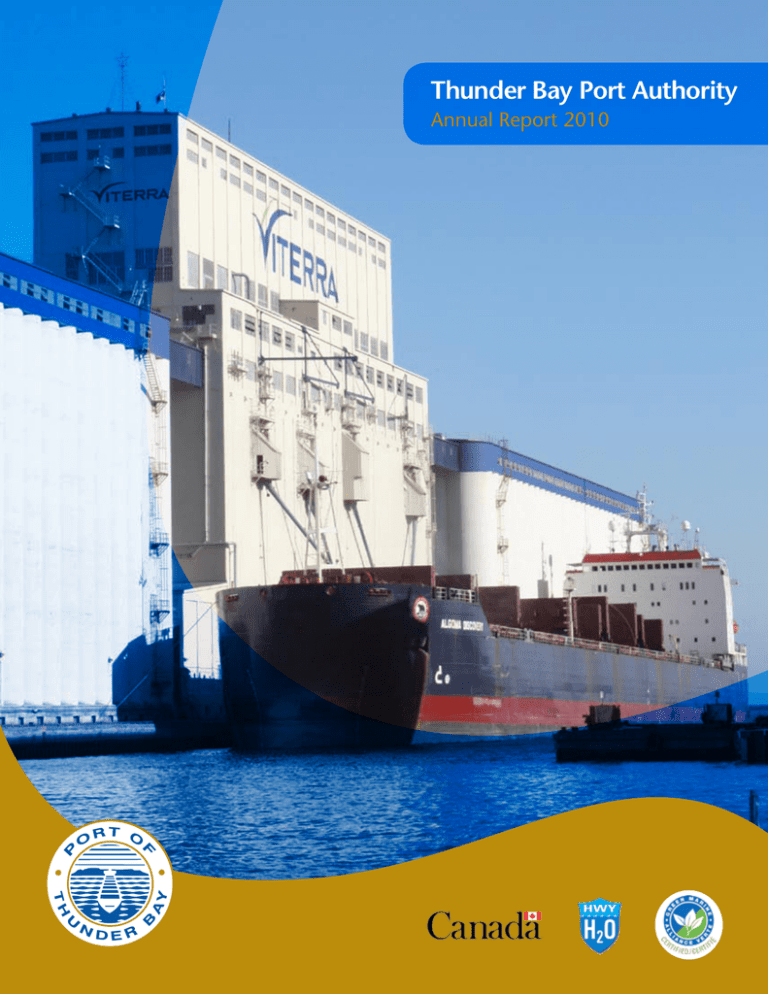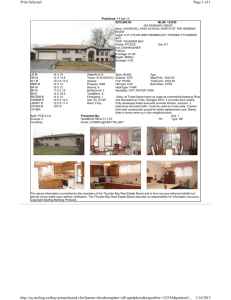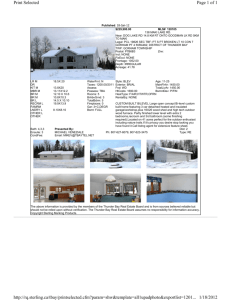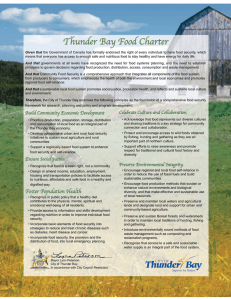Annual Report - English
advertisement

Thunder Bay Port Authority Annual Report 2010 Message from the Chair The Port Authority’s initiative to diversify cargo handled at Keefer Terminal gained momentum over the past season. In addition to shipments of wind turbines to western Canada, the port handled the Peace Bridge originating in Spain and destined for the city of Calgary, oilsands equipment, and the export of components of a methanol plant from Edmonton destined for China. The majority of the project cargo ships were loaded with grain at the port for the return trip to Europe. The Authority continued to expand laydown areas at Keefer to facilitate further growth in project cargo shipments. The 25 per cent import duty on foreign vessels was lifted in 2010 which we believe was a major factor in the investment of $400 million in new ships for the Great Lakes. These vessels will have greater cargo carrying capacity, reduced fuel consumption, increased speed and provision for the latest in ballast water treatment technology. For the first time in history, the Canadian Wheat Board announced that it will be purchasing two of the new lake vessels, demonstrating the western Canadian farmers’ confidence in the Seaway system. As part of a major capital plan the Port Authority advanced its development plans for its Intercity property and is in the process of planning the demolition of the former UGG “M” elevator. It is our belief that this property provides an excellent opportunity to attract marine-related business to the city. One of the key issues remains the lack of understanding and awareness of the current and future potential of the Seaway, the world’s largest inland waterway. We continue to work with all levels of government to raise the profile of the port and the waterway. The success in the project cargo initiative demonstrates that the Seaway route can competitively link Europe with the growing market in western Canada. The world’s greatest increases in grain consumption are forecast to occur in Africa and the Middle East leading to predictions of improved tonnages through the Seaway. Increasing demand for bulk shipments from western Canada will create new opportunity for the available capacity in Thunder Bay. On behalf of the Board I would like to express our appreciation to the staff for their dedication and hard work throughout the year. Fred Stille Chair of the Board 1 Thunder Bay Port Authority Thunder Bay Port Authority Board of Directors The ongoing success of the Port of Thunder Bay benefits Thunder Bay and the region. Industry leaders bring decades of experience to the Thunder Bay Port Authority Board of Directors. Each level of government – federal, provincial and municipal – names a director for a three-year term. The federal Transport Minister, on the recommendation of port users, names the remaining four directors. The Board is autonomous and elects its own chair. The Authority promotes and invests in the Port of Thunder Bay’s infrastructure and participates in regional economic development. To remain a competitive player within the Port System, the Authority uses first-rate facilities, professional services, and new technologies to improve operations, enhance performance, and build the future. Fred Stille Chair Port User Director Pritam Lamba Past Chair Nicholas Pustina Vice Chair Municipal Director Lorne Crawford Port User Director Maria Hudolin Port User Director Ed Metzler Federal Director David O’Brien Provincial Director Management Timothy V. Heney Chief Executive Officer Melvin H. Parker Comptroller & Corporate Secretary Guy P. Jarvis Director of Engineering & Harbour Master Annual Report 2010 2 Mission The Mission of the Thunder Bay Port Authority is to promote and invest in the efficient integration of marine, rail and road transportation systems and to support economic development. Vision The Vision for the Port of Thunder Bay is to be Western Canada’s preferred gateway for cargo transiting the Great Lakes – St. Lawrence Seaway System. Strategic Objectives • Diversify marine cargo • Raise port profile • Pursue strategic investments In December 2010, Thunder Bay’s City Council designated Thunder Bay Port Authority lands as Community Improvement Plan area. The designation provides for tax relief on new investment on Authority lands, and is a significant tool for attracting new opportunies to Thunder Bay. 3 Thunder Bay Port Authority Thunder Bay Port Authority (TBPA) is optimistic about the long-term future of the Port of Thunder Bay. The Port is the western Canadian terminus of the St. Lawrence Seaway System, the longest inland waterway in the world. The opportunities and challenges are largely determined by the Port’s strategic role as it relates to the Seaway corridor. The Port was built to provide access to European markets for western Canadian grain producers through the longest grain supply chain in the world. For the past five years, an integral part of TBPA’s strategy has been expanding the number of project cargo ships that come through the Port Authority’s Keefer Terminal. Each shipment results in significant economic impact to the region as well as providing backhaul capacity for grain exports. TBPA works with its strategic partners to coordinate the activities of stevedores, trucking companies, equipment operators, railways and fabricators to ensure that project cargo is handled efficiently and provides value to the shipper. Annual Report 2010 4 CANADA’S GATEWAY To THE WEST wind turbines: various vessels summer 2010 In 2010, five shipments of wind turbine components were handled at Keefer Terminal. 39,000 cubic metres of parts were transferred from vessel either directly to trucks or to laydown areas for storage and staging. BRIDGE PARTS: OSC VLISTDIEP SETEMBER 2010 In September, oversized bridge parts arrived at Keefer Terminal on the OSC Vlistdiep. The parts were travelling from Spain to be used in the construction of Calgary’s Peace Bridge over the Bow River. Hauled from Thunder Bay by truck, these pieces were the widest loads ever carried out of Keefer Terminal by truck at 19’ 6”. MACHINERY: DUTCH RUNNER OCTOBER 2010 The Canadian vessel Dutch Runner berthed at Keefer Terminal in October. The Dutch Runner carried a shipment of pressure vessels from Southern Ontario which are currently being stored at the Terminal for eventual continuance to the Oilsands in Northern Alberta. METHANOL PLANT PARTS: PALEMBANG NOVEMBER 2010 Components of a disassembled methanol plant were exported from the Port in November. The plant parts were transported from Edmonton to Keefer Terminal by train, where they were loaded onto the Palembang. The Palembang carried the parts to China where the plant is being reassembled. 5 Thunder Bay Port Authority The Great Lakes passenger vessel Clelia II made ten stops in Thunder Bay during the summer of 2010. Over 750 passengers enjoyed daytrips to Thunder Bay which included visits to Fort William Historical Park and local shopping. The Port of Thunder Bay has the largest grain storage capacity in North America at 1.2 million tonnes. Wheat, durum, coarse grains, oilseeds, feed grains, peas and other pulse crops as well as various grain by-products are handled annually at Thunder Bay’s eight grain terminals. Annual Report 2010 6 thunder bay port authority balance sheet As at December 31 2010 2009 Assets Current Cash Accounts receivable Other receivable Prepaid expenses $ 323,146 $ 429,038 85,846 41,640 879,670 Long term investments 18,980,116 Property, plant and equipment (net) 18,198,573 $ 38,058,359 180,409 300,300 54,041 534,750 18,589,175 18,451,346 $ 37,575,271 Liabilities and Equity Current Accounts payable and accrued liabilites $ Deferred rental income 561,807 $ 64,847 530,108 67,649 626,654 597,757 Equity Contributed surplus 27,711,964 27,711,964 Retained earnings 8,705,024 8,270,647 Accumulated other comprehensive income 1,014,717 994,903 37,431,705 36,977,514 $38,058,359 $ 37,575,271 financial report 2010 The Thunder Bay Port Authority is mandated by the Canada Marine Act to be financially self-sufficient. The Authority’s operating revenues are comprised of Keefer Terminal revenue, Intercity Site revenue, harbour dues and lease revenues from lands under its administration. Keefer Terminal revenues represented 61% of the Authority’s operating revenue in 2010. Net earnings for the year were $434,000. These results reflect a continuing commitment to effectively manage operating costs and maximize return on the Authority’s assets. For further details, please refer to the financial statements included in this report. Since becoming a Port Authority in 1999, TBPA has spent in excess of $8 million on capital improvements, dredging and infrastructure. The Authority has developed a 5-year, $12.3 million capital budget that provides funds for several major strategic projects. The current annual advertising and public relations budget of $100,000 is indicative of TBPA’s efforts to maintain the port profile locally, nationally and internationally. 7 Thunder Bay Port Authority statement of earnings For the year ended December 31 2010 2009 Revenue Terminal Harbour Harbour Park Intercity $ 1,351,233 $ 576,146 169,745 127,717 1,356,443 613,891 169,349 35,212 2,224,841 Expenses 2,174,895 602,210 152,056 134,511 1,022,132 602,850 126,711 80,234 899,526 1,910,909 1,709,321 Terminal Harbour Intercity Administrative and Marketing Earnings from operations before the following 313,932 465,574 Payments in lieu of municipal taxes (268,679) Gross revenue charge (60,694) (292,690) (60,056) (15,441) Amortization (410,087) Earnings (loss) from operations (425,528) 112,828 (441,724) (328,896) Investment income 859,905 841,361 Earnings for the year $ 434,377 512,465 $ laydown construction Construction commenced on the expansion of cargo laydown areas at Keefer Terminal in 2010. Laydown areas are used to store and stage project cargo, providing additional value for the shipper. Annual Report 2010 8 cargo statistics • Grain remains the major port commodity accounting for 75% of total shipments. In 2010, 5.2 million tonnes were shipped, a decrease of 10% from 2009 • Coal shipments rebounded by 14% in 2010 to 1.1 million tonnes • There were 368 vessel calls in 2010, compared to 375 in 2009 • Foreign vessel calls increased by 22% from 58 in 2009 to 71 in 2010 • Thunder Bay remains the largest grain port and the only potash load point on the Great Lakes • Potash shipments increased by 82% in 2010 to 314,000 tonnes December was the Port’s busiest month of 2010 in tonnage and vessel calls. Domestic and foreign vessel calls were the highest for the month since 1998 and 2005, respectively. During one 24-hour period, nine vessels departed the Port of Thunder Bay with cargoes totalling 154,780 tonnes. Keefer Terminal Project Cargo 60000 8 7 50000 40000 5 30000 4 3 20000 2 10000 0 1 2004 2005 2006 No. of Vessels 99 Thunder Authority ThunderBay BayPort Port Authority 2007 2008 Freight Tons 2009 2010 0 No. of Vessels Freight Tons 6 cargo statistics TONNES BY COMMODITY 2010 2009 Grain 5,219,784 5,837,252 Coal 1,062,891 930,105 313,952 172,173 95,901 153,903 158,953 178,913 10,986 13,553 6,862,467 7,285,899 Potash Dry Bulk Liquid Bulk General Cargo TOTAL cargo shipments Annual Report 2010 10 Bro oks 165˚W Ra ng e WESTERN CANADA FREIGHT CORRIDOR Mt Mckinl Mckin kinle inle nley nss e Mountai Mackenzie 150˚W Queen een n Cha harlotte ha rl e Is sslands Cape Ho owe o w British Columbia PROJECT CARGO CORRIDOR Alberta Saskatchewa skatchewa an Vancouver Isla Va an nd Manitoba to 45˚N Ontario rio GRAIN CORRIDOR 135˚W Quebec THUNDER BAY Nova Scotia i a n M t s . G r e a t Cape Cod c h Death Valley Guadalupe ad pe e l a p p TWO-WAY CARGO Cap C Ca pe Ha p atteras a B Bermuda A 30˚N a P l a i n s Mojave ve Sie j a B a rra ra M dre Sier Ma a n i o r l i f C a Long Island nd tal ntal en Orie cid Grain adre Oc 15˚N Project Cargo Sier ra M Picco co de de Orizab Oriza Orizaba adre Del Yuc Yucatan Y u uc Peninsu P Penins nsula nsu G r e a t e r A n t i l l e s Sur L e s s e r A n t Isthmus Isthmu us of Panama P ama 0˚ 120˚W 0˚ 105˚W 90˚W 75˚W 0 0 500 K Parallel scale at 4 11 Thunder Bay Port Authority Shipping cargo through the Seaway utilizes the greenest mode of transportation. Marine transport uses less than half the fuel of rail transport and about one tenth the fuel of trucking. CO2 emissions are reduced by 30% and 85% compared to rail and trucking, respectively. As the Lake Fleet is revitalized, fuel efficiency and emission reductions will make the greenest mode of transportation greener. Nova . Cape Cod a n M t s Vessel l a p p Cape Hatteras A P l a i n s a c h i G r e a t Rail Canadian Seaway users are investing more than $400 million in the revitalization of the Seaway’s Lake Fleet, which will greatly reduce the carbon footprint of the Fleet. Canada Steamship Lines, Algoma Central Corporation and the Canadian Wheat Board have ordered new vessels with state-of-the-art design and technology. Pictured is the new Equinox Class vessel which has been ordered by both Algoma and the Wheat Board. tal rien re O Mad Features of the Equinox Class vessel: • 40% reduction in air emissions • Superior fuel efficiency due to minimized resistance and an energy-recovering rudder • Maximized cargo-hold capacity • Minimized noise and vibration levels • Space for ballast water treatment technology Long Island to be installed in the future Hispaniola 2010 highlights and events Top Hat Ceremony April 2010 Lake Superior Day July 2010 Visit from Taipei Director General July 2010 13 Thunder Bay Port Authority ACPA Conference August 2010 OMTF Marine Night September 2010 H.M.S. Bounty Visit August 2010 Grain Transportation Meeting September 2010 Annual Report 2010 14 keefer terminal Cargo Laydown Area Breakbulk / General Cargo Heavy-lift Rail Track Clear Span Breakbulk / General Cargo 1 Warehouse 3 2 4 Clear Span Cargo Handling Facility Coast Guard Property Main Gate Administration Building THUNDER Thunder BAY Bay PORT Port AUTHORITY Authority 100 Main Street, Thunder Bay, ON P7B 6R9 807.345.6400 ||807.345.9058 807.345.9058 tbport@tbaytel.net ||www.portofthunderbay.ca www.portofthunderbay.ca Rail-Yard (200 car capacity)





